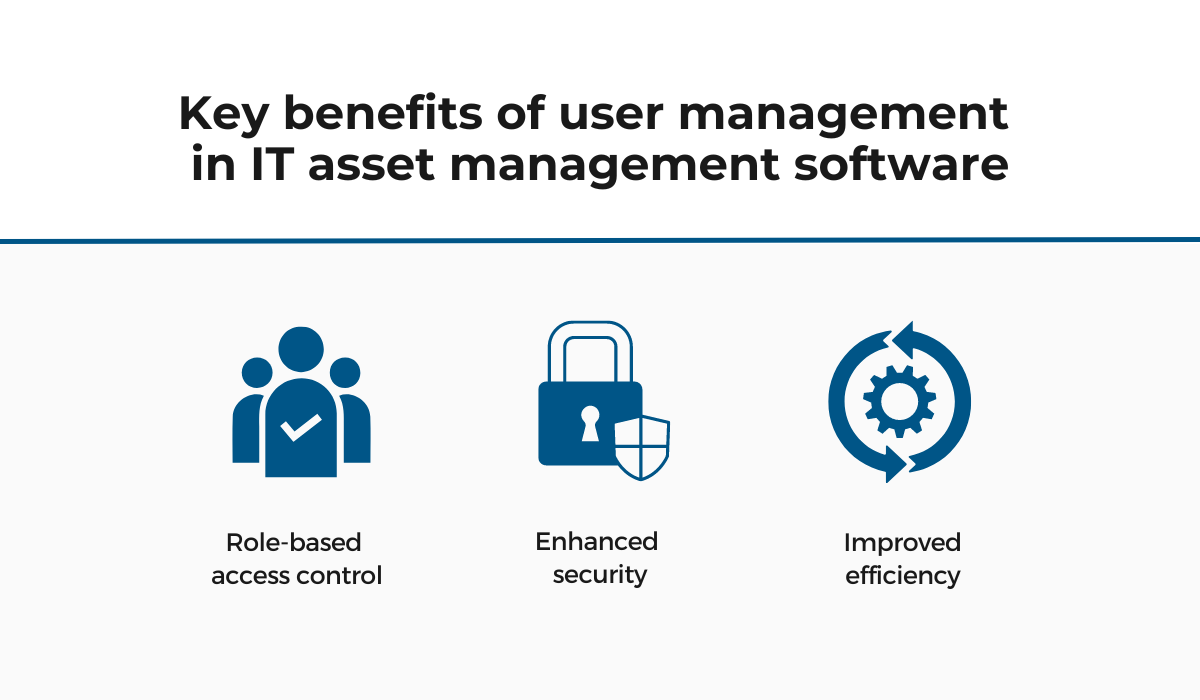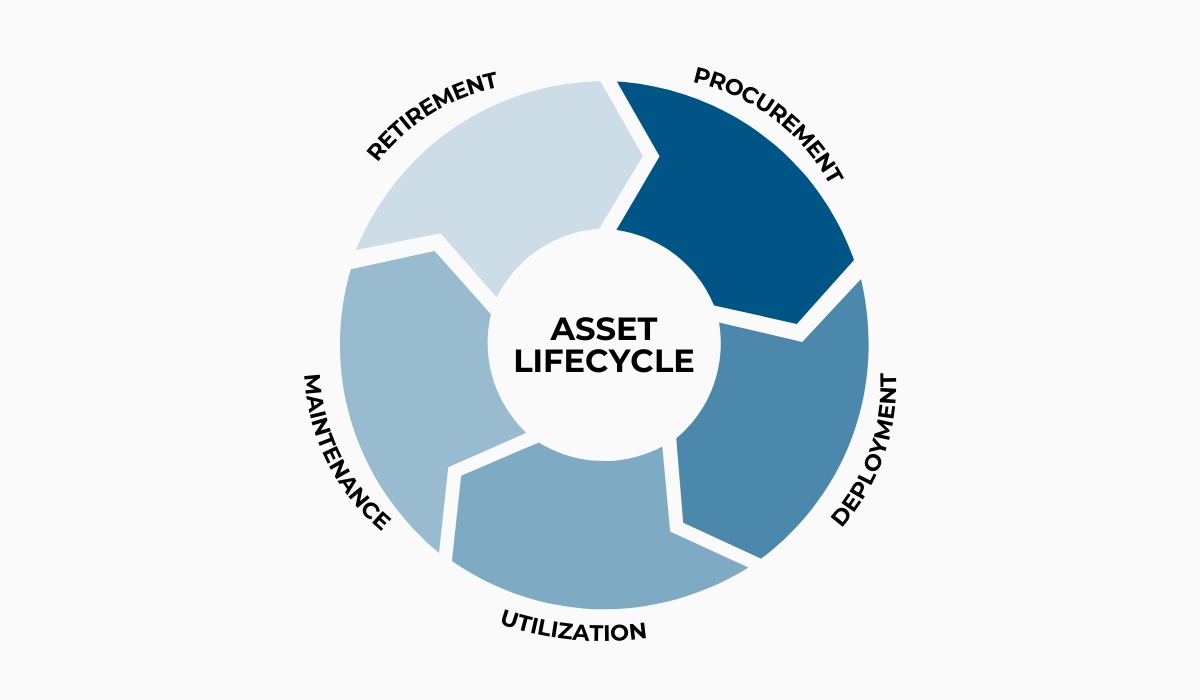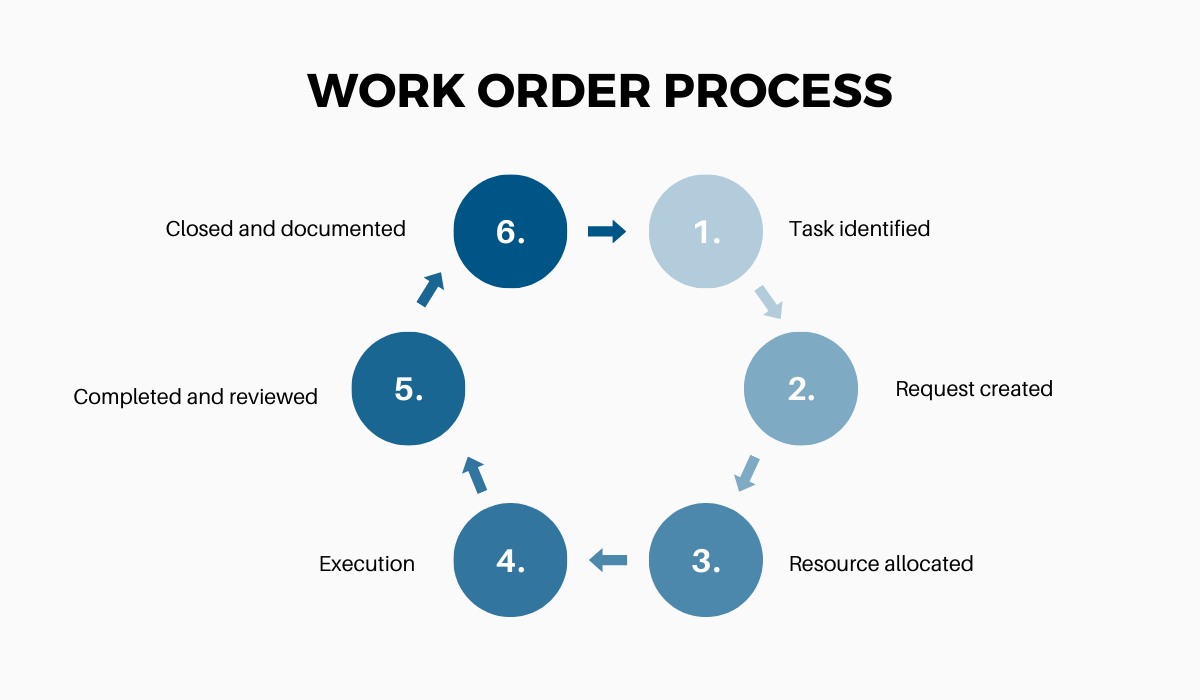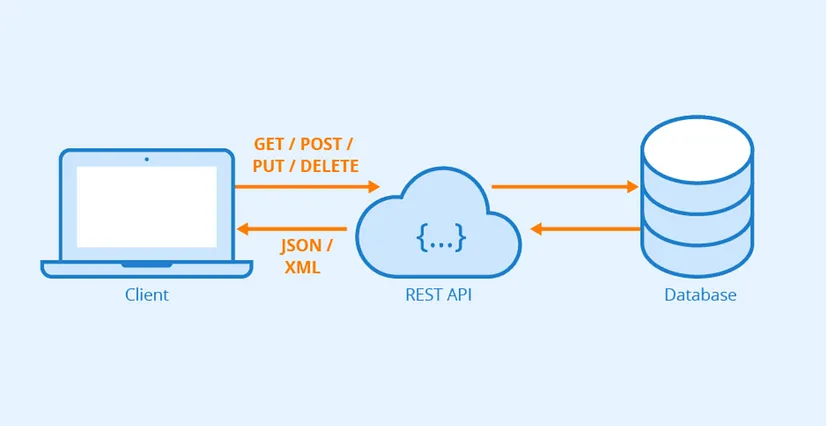Searching for the perfect IT asset management software can feel like wandering through a labyrinth, especially when you’re not sure which features to prioritize.
The myriad of choices out there, often described in technical jargon, can further muddy the waters.
Because we all thrive best with a little guidance, we’ve put together this handy article that will dispel the fog, and reveal the 12 essential features you need in managing IT assets.
In this article...
User Management
When it comes to IT asset management software, one feature to keep your antennas tuned to is user management.
As the name suggests, this feature refers to how a system handles its users. It controls who has access to what within a specified system, and outlines the levels of permission each user has.
Why does this matter when choosing IT asset management software?
The answer lies in three compelling reasons: control, efficiency, and security.

Regardless of its size, a multitude of roles undeniably make up the structure of every company.
For instance, IT administrators, asset managers, and auditors might all require access to the system. However, the level of access each of these roles mandates will differ substantially.
IT administrators, for example, will probably need complete access, including adding or deleting users and changing their status.
Conversely, auditors might only need read-only access to review the assets during periodic inspections, and asset managers might require a degree of control somewhere in between.
A good IT asset management software needs to handle these different roles and their corresponding access levels.

It needs to ensure that every user can perform their tasks without inadvertently changing data they shouldn’t be touching.
Beyond these two benefits, user management also bolsters security, as each user is designated a unique login. In case issues arise—data changes, missing assets, etc.—having robust user management helps identify where things might have gone wrong.
Therefore, given the integral role that user management plays in ensuring the seamless operation and security of your IT asset management, it’s paramount to confirm it’s present within the chosen software.
Lifecycle Management
When it comes to choosing IT asset management software for your company, you might not immediately think of lifecycle management as a critical feature.
However, considering the benefits it brings to the table, its contributions to managing assets from procurement, through deployment and eventual retirement can’t be ignored.

Firstly, in many companies, especially those with a lot of IT assets, challenges such as forgotten maintenance schedules, overlooked warranty periods, or unnoticed software license expirations can become commonplace.
However, with lifecycle management, as shown in the image below, this information is presented on the timeline of the particular asset.

This way, monitoring and tracking the due dates of such events becomes more manageable.
Next, lifecycle management aids in cost savings. Knowing what stage an asset is at lets you foresee and avoid costs associated with premature upgrades or delayed retirements.
Finally, it maximizes asset use. By knowing where an asset is in its life, you can guarantee it’s earning its keep and not just collecting dust on a forgotten shelf.
Therefore, when it comes to picking the perfect IT asset management software, don’t just select any.
Considering all these perks, give priority to those boasting sturdy and comprehensive IT asset lifecycle management features.
Depreciation Calculation
Within the context of IT asset management, there’s a vital metric that successful companies never lose sight of—the diminishing worth of assets with time, or depreciation.
While the procurement and maintenance of IT assets sit front and center, calculating and tracking the depreciation of these assets is equally crucial.
Why? Because understanding the depreciated value of your IT assets provides a more accurate representation of how much of an asset’s value has been used.
This allows businesses to pay for these assets over a specific period of time while they generate revenue.
Depreciation also provides tax benefits. Businesses can claim depreciation for a business asset over its useful life or take accelerated depreciation for eligible assets.
Therefore, the ideal IT asset management platform should offer a robust depreciation calculation feature—functionality that lets you compute and track depreciation with accuracy and ease.
If you, for example, use GoCodes Asset Tracking for managing your IT (or any other) assets, you’d be able to calculate depreciation through our “reports” feature.
There, you can choose from various types of depreciation calculations:
- Straight Line Annual Depreciation (for reference purposes)
- Prior Year Depreciation (for last year’s tax year filing etc.)
- Current Year Depreciation
- Total Depreciation for all years
- Balance remaining to be depreciated
The reporting tool provides you with all that’s necessary to calculate the value of assets as they change over time.
Following the calculations, you can export the data to customized reports.
This example shows how something that’s complex in nature can be extensively streamlined with relevant IT asset management software.
This feature won’t just simplify processes but also furnish you with a thorough understanding of your assets’ real worth.
Asset Tracking
Managing IT inventory can be challenging when there’s no structured system in place.
It can lead to assets being misplaced, forgotten, or underused, ending up in unnoticeable corners of your central office, abandoned storage rooms, or at remote workers’ home offices.
Therefore, every IT asset management software should encompass a robust tracking system.
Why? Because asset tracking affords you clear visibility across your entire inventory, detailing:
- What assets you have
- Where they’re located
- How they’re being utilized
- Their lifecycle stage
Let’s now see how this all comes together using a real-world example from GoCodes Asset Tracking.
As an advanced asset management software, GoCodes Asset Tracking cleverly integrates customized QR code labels into its asset tracking mechanism.

These labels are designed to be applied to each of your IT assets.
Using the accompanying smartphone app, you can then scan these labels, and the software will instantly update an item’s location, condition, or any other relevant parameter within your system.
The result? Access to real-time, reliable data for each and every asset.
Investing in the right asset-tracking solution is crucial—it’s considered a pillar of IT asset management.
To save yourself from an inventory headache, double-check that your chosen software features an advanced, user-friendly tracking system.
Check-in and Check-out
Companies typically possess hundreds of IT physical assets—computers, laptops, tablets, projectors, printers, audio devices, servers, hard drives, mobile phones, and more.
These assets are continually being updated, distributed, utilized, and returned.
Now imagine the disorganization that would ensue if there was no structure governing the flow and usage of these resources.
This is where the check-in and check-out feature embedded in the IT asset management software saves the day.
It works similarly to borrowing a book from a library. When users are given an IT asset, they check it out and when they return it, they check it in.
Let’s bring GoCodes Asset Tracking back into the picture to show you how this system works.

Every time an employee scans the QR code label, this action checks out the asset for that employee, records the location, and even includes any relevant notes associated with the equipment.
When the asset is returned or checked in, the process is just as simple. Another quick scan and all the data is updated.
Not all IT asset management tools have this feature as a part of the package.
Considering how it streamlines the process of keeping track of your assets, it shouldn’t be subject to compromise.
Service Scheduling
Just imagine a typical workday thrown into disarray because of an unexpected server crash or software glitch.
Pertinent projects get delayed, man-hours are wasted, and before you know it, you’re dealing with mounting costs.
Every asset has an optimal lifespan. And if it doesn’t go through regular service, situations such as these can easily happen.
However, with software that features service scheduling, you’re in the driver’s seat—predicting issues, preempting faults, and planning repairs at your convenience to avoid disruptions, as shown below.
For that reason, GoCodes Asset Tracking has a “tasks” feature, where you can schedule and assign service tasks to your equipment. See it in action:
In most cases, the IT asset management software sends automatic reminders when an asset is due for upkeep.
This way, keeping track of each asset’s maintenance schedule becomes easier to handle.
Integrating service scheduling can also have a positive impact on your company’s profitability.
Deloitte’s research indicates that companies adopting predictive maintenance, such as scheduled servicing, have experienced:
- A decrease in maintenance costs by up to 40%
- A reduction in downtime by 70%
- An increase in overall productivity by 25%
Therefore, regular servicing not only elongates the lifespan of an asset but also ensures that it works at its highest efficiency during its lifecycle.
Keep this in mind when choosing IT asset management software.
Work Order Management
Often overshadowed by more flashy features, work order management proves to be an unsung hero in maintaining the seamless performance of IT assets.
Its ability to document, assign, and track every repair request, maintenance check, or upgrade allows you to switch from a reactive stance of constantly putting out fires to an organized, proactive strategy.
The work order process in IT asset management is cyclical in nature. It begins where it ends—in the need of asset maintenance or upgrade.
The cycle usually follows these steps.

In the first two steps, the task is identified, and the request is created by filling out the form provided by the tool.
Next, the process requires the allocation of necessary resources. This involves task assignment to the right personnel and the provisioning of required tools and parts.
Following the setup, the execution of the work order ensues.
After the completion of the work order, a thorough review takes place to ensure the job was carried out successfully.
The final stage in the cycle is the outright documentation of the work order, where every detail concerning the task will be recorded for future reference.
The series of these actions constitute a typical work order process.
With a respective IT asset management tool, all these steps are handled through a dashboard where everyone involved is notified about the creation of a work order and can follow it through until resolution.
This reduces the chances of human error and improves efficiency by handling everything in one place.
It also beats by a huge margin inefficient email threads and cumbersome manual documentation.
Notifications
In IT asset management, one aspect that often slips under the radar yet holds the key to smooth operations is the functionality of notifications.
As an early warning system, they flag critical aspects such as pending updates, impending deadlines, necessary maintenance activities, low inventory, overdue assets, or other potential concerns.
They usually come in the form of alert messages within the software, texts, or emails, as illustrated below.

They allow you to preventively tackle potential issues, and eliminate roadblocks that could disrupt the project’s schedule.
However, not all notifications are created equal. If you’re bombarded with too many or irrelevant alerts, it could lead to notification fatigue, where critical updates could get missed.
Therefore, a nice-to-have feature within IT asset management software would also be the ability to customize notifications and stipulate when, why, and how you’d like to be notified.
All things considered, notifications are far more than just peripheral features—they’re at the core of efficient IT asset management.
Consequently, prioritize software that provides reliable notification functionality.
Audit Mode
Without a doubt, many companies struggle with accurately pinpointing the number of IT assets they have, let alone their specific locations.
With remote working arrangements, multiple office locations, and unstructured processes, it’s easy to see why auditing these assets can become less of a stroll and more of an uphill climb.
A practical solution is to choose IT asset management software that comes with an integrated audit mode.
Using an app on your smartphone or tablet in audit scanning mode, you can conduct on-site audits through barcode scanning.

This process automatically updates the asset’s location and confirms its physical presence, the date, and the name of the auditor.
All this information is stored in one place, which is crucial when carrying out asset audits in bulk.
With such a system in place, you’ll gain an unambiguous understanding of the extent of assets within your inventory.
What is more, your financial and accounting departments will gain a significant advantage when dealing with annual tax returns and financial statements.
One word of caution before you dive in. Not all IT asset-tracking systems incorporate this critical feature, it’s typically found in the more advanced solutions.
Hence, it’s crucial to verify its presence prior to your software purchase.
Custom Reporting
Given the scale and complexity of IT asset databases, the ability to generate custom reports is a feature that should not be passed over.
Custom reporting allows you to adapt the information derived from your asset database to your requirements and priorities.
This is important because, in many instances, teams spend valuable time manually sorting through cookie-cutter reports to locate the information they need.
Custom reporting, on the other hand, brings your most relevant data into focus.
It enables you to highlight valuable details, determine your preferred data structure, and even set up automatic report generation.

Ideally, you should also be able to filter, combine, and present information, in a way that’s easier to digest.
For this purpose, most advanced tools let you add visually interesting charts such as line graphs, pie charts, and bar charts, as well as more sophisticated bubble charts.
An attribute well worth watching out for is the option to import data from external sources, like Excel spreadsheets.
As numerous businesses, yours might be one, rely heavily on spreadsheets for a variety of tasks, this feature can aid in operational efficiency.
So when you’re on the lookout for IT asset management software, remember to find the one that checks these boxes.
Integrations
While many features contribute to an effective IT asset management system, the role of integrations is hard to overstate.
Simply put, integrations allow your IT asset management software to “talk” to your other business tools, syncing data across multiple platforms.
One of the most popular options for integration is REST/JSON-based API.
The REST (Representational State Transfer) architectural style is a popular way of building these APIs, thanks to its simplicity and scalability.
JSON (JavaScript Object Notation), notes the format of the data being sent and received, renowned for being lightweight and easy to read.

Put simply, a REST/JSON-based API acts as a translator, allowing your IT asset management software to communicate effectively with your other software solutions.
A capable IT asset management software does not just sit in a silo.
Rather, it interacts with your existing software infrastructure, enhancing processes while offering a consolidated view of your assets.
Thus, when selecting your IT asset management software, one of your key criteria should be the ability to achieve seamless and efficient integrations.
Offline Mode
When your operations span across places where internet service may be inconsistent or entirely unavailable, the last thing you want is IT asset management software that’s rendered inoperative due to network unavailability.
The solution? Software with an offline mode that allows you to perform valuable operations on your IT assets even when your network connection is nonexistent.
What happens when you return to an area with coverage?
The offline changes you’ve made on your resources and schedules are synchronized and shared across all your other devices in real time.
Let’s take our product, GoCodes Asset Tracking, as a practical illustration.

With GoCodes Asset Tracking, you can work offline simply by scanning the GoCodes Asset Tracking QR code. This action updates a stored copy on your phone.
As soon as you reconnect to the internet, any changes made offline propagate to your actual database—keeping your information precise and up-to-date.
In other words, this feature allows you to maintain an unbroken workflow and data integrity regardless of connectivity.
So, if you’re handling IT assets in places with limited internet access, prioritizing a tool with offline features would be a smart move.
Conclusion
And there you have it—you’ve just walked through the necessary 12 features your IT asset management software should possess.
When navigating the many options available, keep these essential features top of mind, ensuring the selection you make caters directly to your company’s distinct needs and specifications.
With the knowledge you’ve now gathered, we fully believe you’re well-prepared to make a sound and effective decision.










